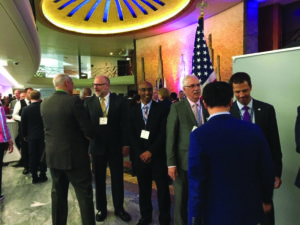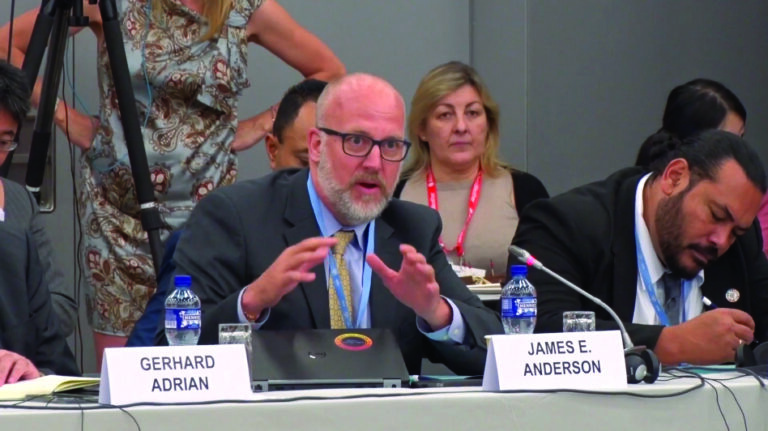The new chair of HMEI, Jim Anderson, talks to Meteorological Technology International about public-private sector engagement, climate change and new technologies
In June 2019, Jim Anderson took on the role of chair of the Hydro-Meteorological Equipment Industry (HMEI) association, replacing outgoing chair Brian Day, who had been in the position since 2011. According to Anderson, who is also senior vice president of global sales at Earth Networks, a provider of weather intelligence data, the main focuses of the HMEI over the next few years will be encouraging more public-private sector engagement and broadening its membership to include more service companies, in addition to equipment manufacturers.
Anderson has worked in the meteorological sector his entire working life and his love for the industry dates back to his education days. “I have always been a bit of an environmental geek,” he says. “I studied wildlife biology and environmental economics as an undergraduate student and went on to get a Master’s degree in environment economics and public policy. I have always been extremely fascinated with the interplay between the environment, industry and public policy.
“From a broader perspective, it has always been extremely important to me, especially in my professional career, to be doing something that is mission driven,” he continues. “I became an environmental geek because I was really interested in the environment and saw it as a critical issue for humankind.”
Anderson joined Earth Networks just over 17 years ago, initially working with the company on a consultancy basis. “I was working on a consulting project with a friend of mine,” he explains. “Earth Networks was still in its early years and had just started experiencing growth. Back then it was primarily a company that gathered weather information for educational and television broadcast purposes. The management team wanted to explore the enterprise area, so I joined to help them do that.”
Public-private engagement
There are a number of things that attracted Anderson to the meteorological sector, one of them being how the public and private sectors work closely together – and this is why one of his key focuses over the next few years at HMEI will be to continue to foster this engagement.
“One of things I enjoy most about working in this sector is the interaction between public and private entities,” he explains. “This is obviously an industry that has traditionally been dominated by the government sector, but this is changing and the growing and dynamic private sector is playing a bigger role every day. I also enjoy the incredible application of technology in the industry – some of the highest performing computing systems in the world are dedicated to weather modeling, and some of the most fascinating physics and science work is undertaken by meteorological experts.”
Anderson believes that the meteorological sector is at an extremely important stage at the moment, as recognition for the important role the private sector can play in the industry is at an all-time high.
“At the WMO’s Congress held in June in Geneva, Switzerland, there was a declaration passed related to public and private sector engagement. It highlighted the importance of the private sector and the need to create a level playing field. It also highlighted the need for governments to engage better with the private sector in their respective countries. This is especially important for addressing some of the problems associated with climate change as the private sector can really help there. The declaration really was a watershed moment for the meteorological industry.”
Anderson believes that governments in countries around the world can learn from how the meteorological sector and its various stakeholders work together in the US. “The US has really overcome the dogma that it is public versus private. Entities in the country work synergistically to promote each other and the work they do. In the US the National Weather Service, NOAA, the FAA, NASA, etc, and private companies all work together and produce some very valuable work. This is a model other countries can learn from.”
In terms of offering advice to other countries and their governments on how they can work more closely with the private sector, Anderson believes that a set of guiding principles could be developed to outline the key steps to take. “The WMO declaration was a starting point and now we need full engagement from both the private and public sectors. The HMEI, and all its members, has embraced this and we work collaboratively with countries’ national hydrological and meteorological services, civil aviation authorities, water agencies, disaster management organizations, etc, in every country in the world. We want to continue to promote this approach as much as possible over the next few years.”
 Engaging with membership
Engaging with membership
The HMEI is the one representative association that has a formal seat at the WMO table, according to Anderson. Therefore it is well positioned to be a strong voice for the private sector in the organization. “Our number-one priority is to engage with the WMO and vigorously promote private and public sector engagement. We want to bring together the opinions of our members and be the one voice representing the private sector at the table,” Anderson adds.
This isn’t the only priority for the HMEI at the moment, however. The association plans to actively engage with its members over the next year to make sure that it understands their interests and promotes their engagement within the HMEI. “One thing we are doing in this area is looking at how we can better represent the entire private sector. The HMEI has traditionally represented the equipment industry, but we now want to encourage more service companies to join the association. The election of myself as chair is a clear indication of this, as about 90% of Earth Networks’ business is in services, not equipment,” Anderson explains.
A further recognition of how the HMEI plans to expand its membership is the creation of a new position specifically representing the services sector on the board. The HMEI plans to fill this position by the end of 2019. The association is also in the process of drafting a survey for its members, as Anderson explains: “This will be a fairly straightforward feedback survey, but will help us understand their key focus areas going forward.
“Another priority for the HMEI is concerned with one of Brian Day’s key initiatives, which was to develop standardized specifications for new tenders. This will help improve transparency and best practices associated with public tenders with enterprises. This is a well-established initiative and work has been ongoing in cooperation with the WMO for a number of years. We have just agreed on the tender specifications and now we are about to pilot them in a few areas.”
Technological development
According to Anderson, the key technologies, which are set to have a big impact on the meteorological sector in the next few years, are cloud computing, AI and remote sensing. “Cloud computing isn’t a new development – a lot of companies in various industries already put most of their assets in the cloud. But in the meteorological sector it hasn’t been adopted that much because traditionally, cloud-based computing systems haven’t had the ability to run weather models in any kind of meaningful way. This is changing now.
“The computing capabilities in the cloud are now matching what you can do in a data center,” Anderson continues. “One great example of how the meteorological sector in the US is using the cloud is NOAA’s creation of the Earth Prediction Innovation Center (EPIC), which aims to address persistent challenges in translating research advances into operational forecasts. It will use cloud computing to enable external researchers to easily contribute to NOAA models.
“Other technologies we will see have a major impact on the meteorological sector in the next few years are AI and remote sensing. The industry hasn’t even begun to scratch the surface of AI, so there is great potential for it to improve forecasts, especially in the area of producing alerts and warnings from models. We will see remote sensing being used more for new observation types,” he adds.
Anderson is extremely optimistic about the future of the meteorological sector, although he believes there are some key challenges that still need to be overcome. “One of the main challenges is making sure national meteorological and hydrological services remain relevant and deliver relevant services to their constituents,” he explains. “Cooperation is key in this area. The industry needs to work together to ensure data is delivered in a usable format and exchanged with the relevant organizations to improve forecasting abilities.”
He is also optimistic about recent changes with the WMO’s commissions: “The radical restructuring of the WMO as a whole, where it has gone from eight commissions down to two, is going to be extremely beneficial for the industry as a whole, which is why now is such an important time in the meteorological sector.
“Looking specifically at the HMEI, I am hopeful that we will continue to grow and ultimately be seen as a key constituent in the global weather enterprise, and that we will represent the entire private sector and not just be seen as representing equipment suppliers,” he concludes.



